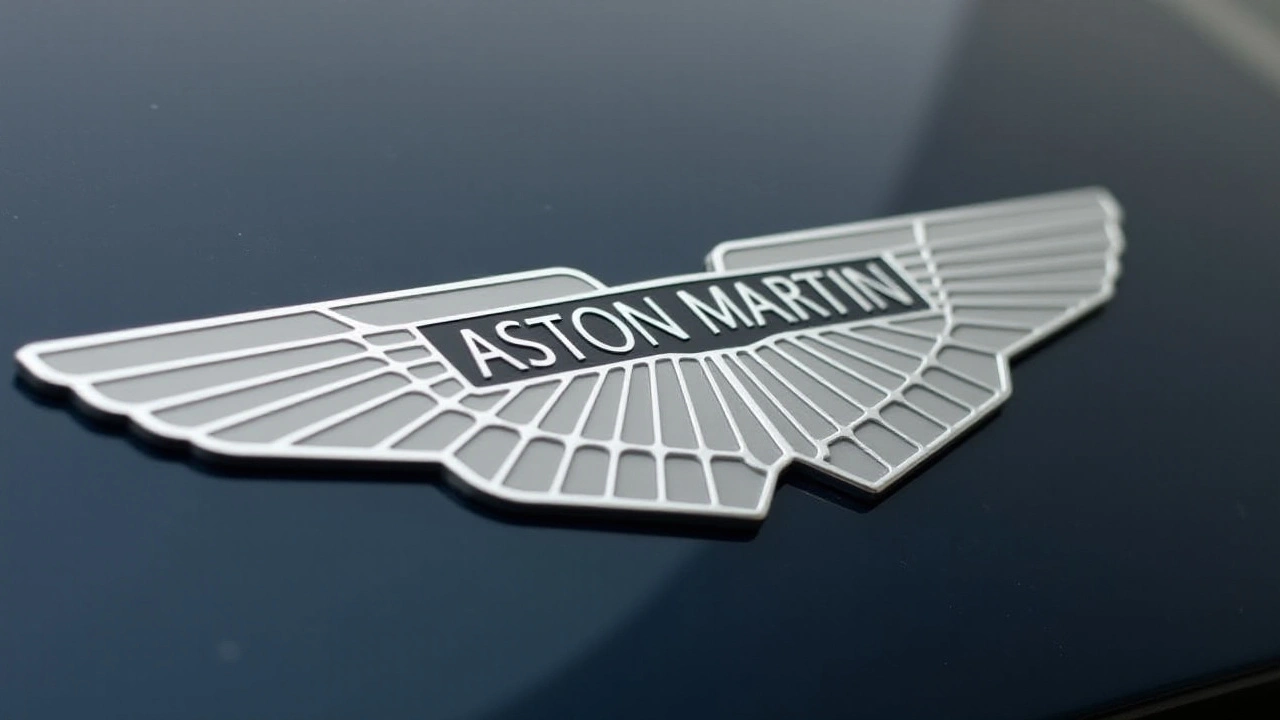Aston Martin's Strategic Moves Amid Financial Challenges: New Fundraising and Profit Warnings

Facing Financial Headwinds: Aston Martin's Current Challenges
Aston Martin, the prestigious British car manufacturer known for its luxury vehicles, finds itself navigating rough waters. The landscape for premium carmakers like Aston Martin has become increasingly challenging, primarily due to factors external to the company's direct operations. At the heart of these challenges is a broader economic slowdown that has reverberated across various industries, sending ripples even into the once-resilient luxury segment. For Aston Martin, these pressures have culminated in the issuance of a second profit warning within two months, a move that has signaled the depth of the financial hurdles looming ahead.
The company's recent revision in its profit forecast indicates an anticipated steep decline from last year's earnings. Aston Martin now predicts its profits for the 12 months ending December 2024 to hit £280 million—a notable dip from the £305.9 million recorded the previous year. Central to this downturn is the delay in the delivery of its high-end Valiant supercars. These vehicles, which can command prices upwards of £2 million, were initially set to bolster the company’s year-end profits significantly. However, the delivery of these coveted cars has been pushed into early 2025. As a result, Aston Martin will miss out on substantial income they had expected for the closing quarter of this year, compounding the pressure on their financial performance.
Production Woes: Component Shortages and Output Reduction
The challenges leading to Aston Martin's profit warning are multi-faceted, extending beyond just the delay of its supercar model. Broader production setbacks have placed additional strain on the company's operations. Critical component shortages have disrupted manufacturing schedules, compelling the company to reduce its anticipated vehicle output for the year. Aston Martin now estimates it will produce 1,000 fewer cars than initially planned. This decision, while necessary under current circumstances, accordingly impacts the firm’s revenue projections and profitability.
These production issues are not isolated, reflecting broader systemic challenges within the global automotive industry. As carmakers jostle with high inflation, increased operational costs, and stiffer competition—particularly from emerging electric vehicle manufacturers—Aston Martin's predicament is a microcosm of the wider sectorial struggles. Many manufacturers, including giants like Ford and Stellantis, have responded similarly by enacting cost-cutting measures, including job cuts and production scaling, as they attempt to navigate the same stormy economic waters.

Raising Capital: Aston Martin's Financial Strategy
In response to these financial challenges, Aston Martin has laid out a strategic plan to raise £210 million to strengthen its financial position. This effort includes a mix of new share issuance and debt financing, showcasing a proactive approach to weather the current economic climate. Specifically, the company aims to raise £110 million through issuing new shares while securing an additional £100 million through debt.
This financial strategy marks a significant step for Aston Martin as it seeks to stabilize its operations and lay groundwork for future resilience. While raising new capital introduces its own set of challenges, such as diluting existing shareholders' stakes, it is a necessary move intended to offset the immediate financial pressures and facilitate longer-term strategic initiatives. Such steps are crucial not only for the firm's survival but also for rekindling investor confidence amid these unsettled times.
The Global Automotive Hurdles: An Industry-Wide Issue
The situation at Aston Martin is far from unique, emphasizing a wider narrative within the global automotive industry—a sector experiencing its share of tumultuous change and evolution. High inflation rates have escalated costs throughout the supply chain, while the competitive landscape grows increasingly fierce. Notably, electric vehicle manufacturers, particularly those from China, are aggressively expanding their market presence, reshaping consumer expectations and exerting transformative pressure on traditional carmakers.
As the demand for electric vehicles rises and market dynamics shift, traditional car manufacturers are grappling with adapting to these new paradigms. Companies must manage legacy production systems while simultaneously investing in the future's green technologies. It is a delicate balance that entails careful strategizing and financial management. Aston Martin's current challenges thus speak to this transitional period within the industry, characterizing a story of adaptation and resilience as much as it is one of crisis.

The Road Ahead: Optimism Amidst Current Struggles
Despite the current headwinds, Aston Martin remains cautiously optimistic about future prospects. CEO Adrian Hallmark has indicated that the company is implementing 'decisive actions' to strategically position itself for success in the long term. This includes upgrading production and delivery channels to ensure stability and consistency in output, which are key to recapturing market strength. Furthermore, Hallmark has underscored the importance of cost management and quality enhancements as vital measures to safeguard profitability and restore financial health.
Progress is already being made on the path to recovery. Aston Martin is steadily reducing its debt and fortifying its balance sheet, initiatives that will undeniably contribute to a more stable financial footing. As the company pushes forward with these reforms, it is positioning itself to embrace new opportunities, leveraging its renowned brand pedigree to expand its presence in the market, particularly with a renewed focus on electrification.
Looking Ahead: Innovations and Market Strategies
The future for Aston Martin, though currently paved with challenges, holds promising prospects. As the company continues its journey toward electrification, it anticipates a revitalization of its model lineup with the introduction of new electric models designed to cater to evolving consumer preferences. This strategic pivot is not just about sustaining current operations but also capturing a larger market share in an industry that is quickly tilting towards sustainability and environmental responsibility.
With the release of new models and adaptations, Aston Martin aspires to regain its foothold in the luxury car sector. The anticipated increase in sales beyond 2025, underpinned by a committed emphasis on electrification and innovation, signals an optimistic outlook. By remaining adaptive and forward-thinking, Aston Martin is poised to reclaim its prominence, navigating through these uncertain times with a focus on sustained growth and innovation.

Eduardo Torres
November 28, 2024 AT 21:51There's a clear need for additional capital to keep the production lines humming, and the £210 million raise should provide that cushion. By mixing equity with debt the company can balance dilution against liquidity, which is a sensible move given the current market squeeze. The short‑term pain may be noticeable, but it lays groundwork for longer‑term stability.
Emanuel Hantig
December 5, 2024 AT 20:31The current headwinds remind us how interconnected the automotive ecosystem really is, and that makes strategic flexibility crucial 😊. A blend of new share issuance and targeted debt can shore up cash reserves while preserving the brand's heritage. Investors will likely watch the debt‑to‑equity ratio closely, and the management’s transparency will be key. If they keep communicating openly, confidence can bounce back.
Byron Marcos Gonzalez
December 12, 2024 AT 19:11Ah, the drama of a venerable marque staring at profit warnings, how utterly theatrical. Avelon‑like ambitions meet the harsh reality of component shortages, and the irony is delicious. The Valiant's delayed debut only adds to the saga, a plot twist worthy of a silver screen. Yet, perhaps this turmoil will forge a rebirth, a phoenix rising from the financial ash.
Chris Snyder
December 19, 2024 AT 17:51From an industry standpoint, supply‑chain bottlenecks have been the primary catalyst for reduced output across many manufacturers. The shortage of semiconductors and specialized parts directly trims the annual production volume, which explains Aston Martin’s 1,000‑car shortfall. Aligning production schedules with realistic component availability can mitigate further disruptions. A data‑driven approach to inventory management could prove valuable here.
Hugh Fitzpatrick
December 26, 2024 AT 16:31Oh great, another profit warning-just what the market needed to feel warm and fuzzy. Nothing says “we've got it all under control” like repeatedly telling shareholders you’re short on cash. At least the CEO’s “decisive actions” sound impressive while the balance sheet screams otherwise. Good luck navigating that storm without a proper compass.
george hernandez
January 2, 2025 AT 15:11The current predicament of Aston Martin illustrates the broader tension between heritage luxury and modern financial discipline. Investors watch the brand with a mixture of reverence and anxiety as traditional cash flows wane. Production delays, especially of the Valiant, carve a noticeable dent in quarterly earnings. Component shortages ripple through the assembly line forcing a recalibration of output targets. The decision to cut a thousand units from the forecast reflects a pragmatic acknowledgement of these constraints. Meanwhile, the company’s appetite for raising capital signals both desperation and strategic foresight. Issuing new shares introduces dilution but also injects liquidity that can underwrite necessary investments. Debt financing, though adding leverage, offers a bridge to sustain operations during the transition. The juxtaposition of equity and debt mirrors the dual nature of the brand-historically elegant yet needing modern agility. Competitors in the electric sphere are accelerating ahead, compelling traditional makers to innovate or fade. Aston Martin’s pivot toward electrification may unlock fresh revenue streams if executed with precision. Yet, the cost of developing battery technology and retooling factories cannot be ignored. A balanced portfolio of internal combustion and electric models could hedge against market volatility. Ultimately, the success of this financial maneuver will be judged by the ability to meet delivery timelines and maintain brand allure. If the company can weather this storm, it may emerge stronger, reinforcing its position in the luxury segment.
bob wang
January 9, 2025 AT 13:51Dear stakeholders, regarding the recent financial disclosures, it is evident that the company is undertaking a multifaceted capital‑raising strategy, which combines equity issuance, debt procurement, and operational restructuring; consequently, this approach aims to shore up liquidity, mitigate immediate cash flow pressures, and lay a foundation for sustainable growth, all while preserving the distinguished heritage of the marque 😊.
Seyi Aina
January 16, 2025 AT 12:31Man, they’re just kicking the can down the road again.